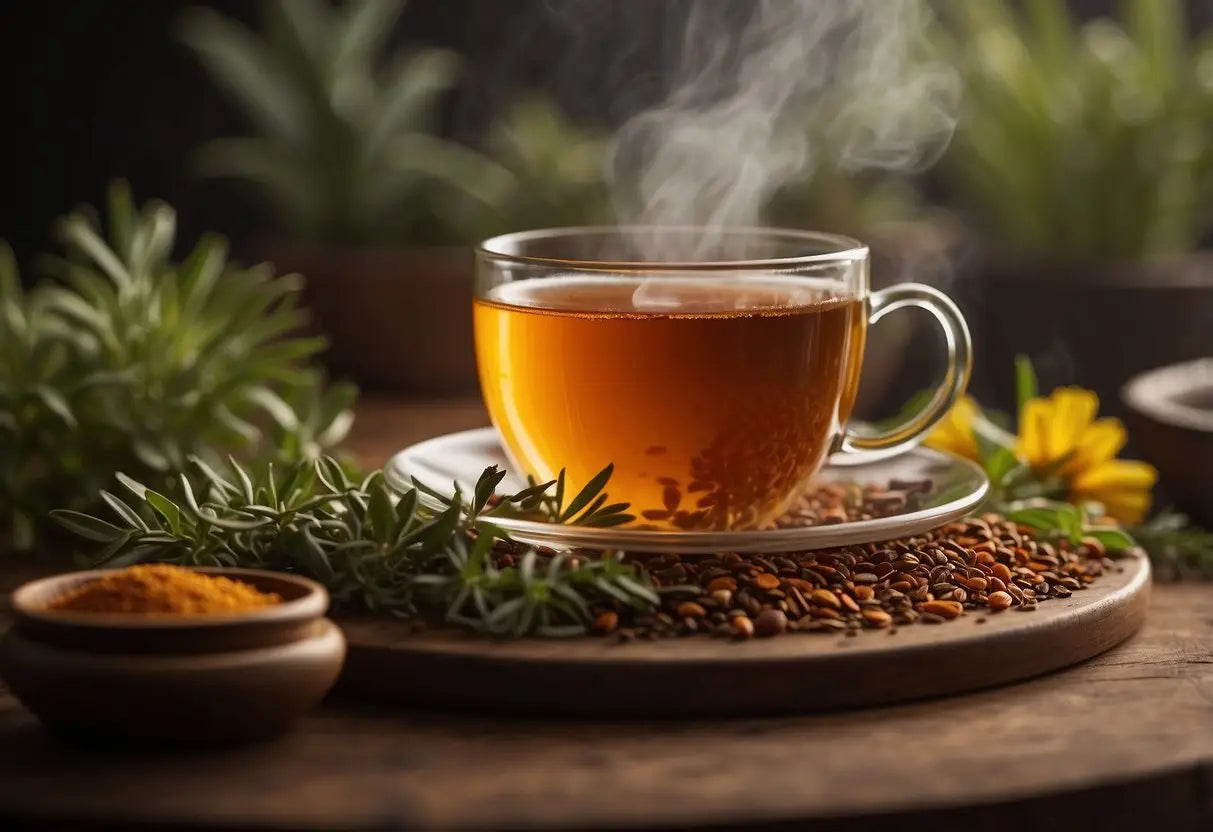Rooibos
Rooibos is a unique herbal tea originating from South Africa, known for its distinct flavor and numerous health benefits. Understand its rich history and the methods used to process this exceptional tea.
Origins and History
Rooibos, also called red bush tea, originates from the Cederberg region in South Africa. Indigenous Khoisan people were the first to harvest and use rooibos for its medicinal properties. In the early 20th century, botanists and settlers began cultivating and commercializing rooibos.
Today, rooibos is internationally recognized and cherished. It's praised not only for its rich, earthy taste but also for its lack of caffeine and low tannin levels. This makes it a popular alternative to black or green tea.
Bestsellers
Processing Methods
The processing of rooibos involves several key steps. Harvesting typically occurs in summer when the leaves are green and succulent. After harvesting, the leaves are chopped and bruised to promote oxidation.
Fermentation is crucial as it converts the green leaves to a reddish-brown color, enhancing the flavor. Some varieties, like green rooibos, are unfermented, retaining a lighter color and a more delicate taste. Drying occurs naturally in the sun, preserving the tea's unique qualities and flavors.
Botanical Characteristics

Rooibos, also known as Aspalathus linearis, is a unique plant with some fascinating botanical features. Understand how this plant species grows and thrives in its natural habitat.
Plant Species
Rooibos belongs to the Fabaceae family and is native to South Africa. It's specifically found in the Cederberg mountains. The plant is a shrub that can grow up to 2 meters tall. It's characterized by its needle-like leaves that are green when fresh and turn red when oxidized.
The species has small, yellow, pea-like flowers that bloom in the spring. These flowers eventually produce small, cylindrical seeds. The plant has adapted to survive in the nutrient-poor, sandy soil typical of its native region.
Growth and Cultivation
Rooibos thrives in a Mediterranean climate with dry summers and wet winters. The plant requires well-drained, acidic soil and plenty of sunlight. These specific conditions make cultivation outside its native region challenging.
Farmers typically plant seeds in the summer months, allowing them to grow in nurseries before transferring them to fields. Plants are harvested by cutting the upper parts of the branches, which are then bruised, fermented, and dried in the sun. Cultivating rooibos sustainably ensures the preservation of this unique plant.
Health Benefits

Rooibos is packed with antioxidants and essential nutrients. It also offers potential therapeutic effects that could be beneficial for various health conditions.
Antioxidants and Nutrients
Rooibos tea is rich in antioxidants, such as aspalathin and quercetin. These compounds help protect your body from oxidative stress and inflammation. Antioxidants can improve heart health by reducing bad cholesterol levels.
Rooibos is also a source of essential minerals like calcium, fluoride, and magnesium. These nutrients support bone health and dental hygiene. You can include rooibos in your diet to benefit from its nutrient profile without consuming caffeine, making it a good option for those sensitive to caffeine.
Lao Ban Zhang
Potential Therapeutic Effects
Rooibos may help manage or prevent several health conditions. For example, its anti-inflammatory properties can alleviate symptoms of conditions like arthritis. Additionally, some studies suggest that rooibos may help regulate blood sugar levels.
This tea might have a positive impact on your skin health. Its antioxidant content can help reduce signs of aging and improve skin conditions like eczema. Rooibos is also believed to support digestion and may help with conditions like acid reflux and colic in infants.
Cultural Significance

Rooibos tea holds a special place both in its native country, South Africa, and globally. It is cherished for its unique flavor and cultural connotations.
Usage in South Africa
In South Africa, rooibos is more than just a beverage. It's a part of daily life and is often enjoyed both hot and cold. Families pass down the tradition of brewing rooibos from one generation to the next.
Rooibos is also a symbol of local heritage. It is grown in the Cederberg region and forms a significant part of the region's identity. Indigenous people have used it for centuries in various forms, including as a tea and healing remedy.
The plant was historically popular among the Khoisan people. They valued it for its medicinal properties, using it to treat ailments such as colic and skin issues. Today, it's common to see rooibos tea served in cafes and homes across South Africa.
Global Popularity
Rooibos has gained international acclaim. Known for its health benefits, it has found a place in the global market as a caffeine-free alternative to black and green teas. You might find it in grocery stores worldwide, often marketed as an antioxidant-rich, healthy choice.
Countries like the United States, Germany, and Japan have embraced rooibos. Many consumers appreciate that it lacks the bitterness of some traditional teas. Health-conscious individuals are particularly drawn to its natural, caffeine-free quality.
The global demand for rooibos has spurred economic benefits for South African farmers. With its expanding market, rooibos farming has increased, providing livelihoods for many in the Cederberg region. This international interest helps preserve the cultural heritage of rooibos for future generations.
Culinary Uses
Rooibos is not only celebrated for its nutritional benefits but also for its versatility in the kitchen. It can be used both as a beverage and as an ingredient in many dishes.
Tea and Infusions
Rooibos tea is perhaps the most well-known use of this herb. You can prepare it by steeping dried rooibos leaves in hot water for about 5-10 minutes. It produces a reddish-brown infusion with a naturally sweet, nutty flavor.
Rooibos infusions are caffeine-free, making them an excellent alternative for those avoiding caffeine. You can enjoy it hot or iced, plain or with added milk and sweeteners.
In addition to traditional tea, rooibos can be infused into cocktails, mocktails, and smoothies. It pairs well with fruits, herbs, and spices, offering a unique twist on standard recipes. Try adding rooibos to your favorite fruity beverages for an added layer of flavor.
Cooking and Baking
Rooibos can also be a versatile ingredient in cooking and baking. You can use brewed rooibos tea as a flavorful liquid in marinades, soups, and stews. Its sweet, earthy notes complement both savory and sweet dishes.
When baking, rooibos can be incorporated into cakes, cookies, and bread. You can either use rooibos tea directly or grind the leaves into a fine powder to blend with flour. This adds a rich color and subtle flavor to your baked goods.
Rooibos can also be used in sauces and dressings, adding depth and complexity. For a unique dessert, try infusing rooibos into custards, puddings, or ice creams. The possibilities are vast, making rooibos a valuable addition to your culinary repertoire.
Sustainability and Trade
Rooibos is grown using practices that prioritize environmental stewardship. The export market has evolved to reflect these sustainable methods, ensuring economic benefits for producers.
Agricultural Practices
Farmers employ water-efficient irrigation methods, crucial in South Africa's semi-arid regions. They also use crop rotation and organic fertilizers to improve soil health.
Key Practices:
- Water conservation: Drip and micro-sprinkler systems.
- Soil health: Organic matter and natural pest control.
- Biodiversity: Maintaining natural vegetation surrounding rooibos fields.
These practices not only protect the environment but also enhance the quality of the rooibos crop.
Export Market
Rooibos’s global demand has surged, with significant markets in Europe, North America, and Asia. Certified organic and fair-trade rooibos attract higher prices, benefiting local farmers.
Major Export Destinations:
| Region | Key Markets |
|---|---|
| Europe | Germany, UK, Netherlands |
| North America | USA, Canada |
| Asia | Japan, China |
Fair-trade certifications ensure better labor conditions and community investments. This emphasis on ethical trade practices enhances the sustainability of the entire rooibos supply chain.
Rooibos in Research

Ongoing investigations have explored rooibos' potential health effects while clinical studies have provided insight into its impact on various conditions. New scientific findings highlight rooibos' active compounds and their potential benefits.
Clinical Studies
Health benefits of rooibos are being evaluated in controlled clinical settings. Some studies have focused on its antioxidant properties, looking at how rooibos might reduce oxidative stress and improve overall wellness. Antioxidants, such as aspalathin and nothofagin, are being studied for their potential to combat inflammation and support immune function.
Clinical trials have also investigated the effects of rooibos on cardiovascular health. Research indicates that consuming rooibos may lower blood pressure and improve cholesterol levels. This is particularly significant for those at risk of heart disease.
Moreover, some studies suggest that rooibos could play a role in managing diabetes. Its active ingredients may improve insulin sensitivity and help regulate blood glucose levels. More comprehensive trials are needed to confirm these findings.
Recent Scientific Findings
Recent research has identified various bioactive compounds in rooibos that could be beneficial for human health. These studies are looking at specific components like polyphenols and their effects on cellular health. Polyphenols have been shown to protect cells from damage and reduce inflammation.
Another area of interest is cognitive health. Preliminary research suggests rooibos may have neuroprotective effects, potentially slowing the progression of neurodegenerative diseases.
Skin health is also being explored, with some studies indicating that rooibos could improve skin conditions like eczema. The anti-inflammatory and antimicrobial properties of rooibos are central to these investigations.
Rooibos' impact on the gut microbiome is emerging as a promising topic. Early research suggests it might promote a healthy balance of gut bacteria, which is critical for overall health.
Consumer Products
Rooibos has diverse applications, ranging from different tea products to beauty and skincare solutions.
Tea Varieties
Rooibos tea is available in numerous forms, each offering unique flavors and benefits.
Loose-leaf rooibos is popular among tea enthusiasts who prefer to brew their tea to specific strengths. This form allows you to control the amount of rooibos used and is often regarded as having a richer taste.
Bagged rooibos tea offers convenience. Pre-portioned and easy to brew, they are perfect for a quick and simple experience.
Flavored rooibos teas include options like vanilla, citrus, and chai. These varieties combine rooibos with other natural flavors, creating blends that suit different tastes.
Green rooibos is less oxidized than traditional red rooibos and has a milder flavor. It is often chosen for its higher antioxidant content and lighter taste.
Beauty and Skincare
Rooibos is a valuable ingredient in many beauty and skincare products due to its antioxidant and soothing properties.
Rooibos-infused creams and lotions are particularly beneficial for their moisturizing and anti-inflammatory effects. These products often target sensitive skin, helping to reduce redness and irritation.
Rooibos facial serums can improve skin elasticity and combat the effects of aging. The natural compounds in rooibos may help reduce fine lines and wrinkles, providing a youthful appearance.
Hair care products featuring rooibos extract contribute to scalp health and stronger hair. Shampoos and conditioners with rooibos can enhance shine and manageability, making them a common choice for hair care routines.
Bath and body products like soaps and bath salts also use rooibos for its rejuvenating qualities. These items offer a relaxing and nourishing experience, leaving your skin soft and refreshed.
← Older post Newer post →











